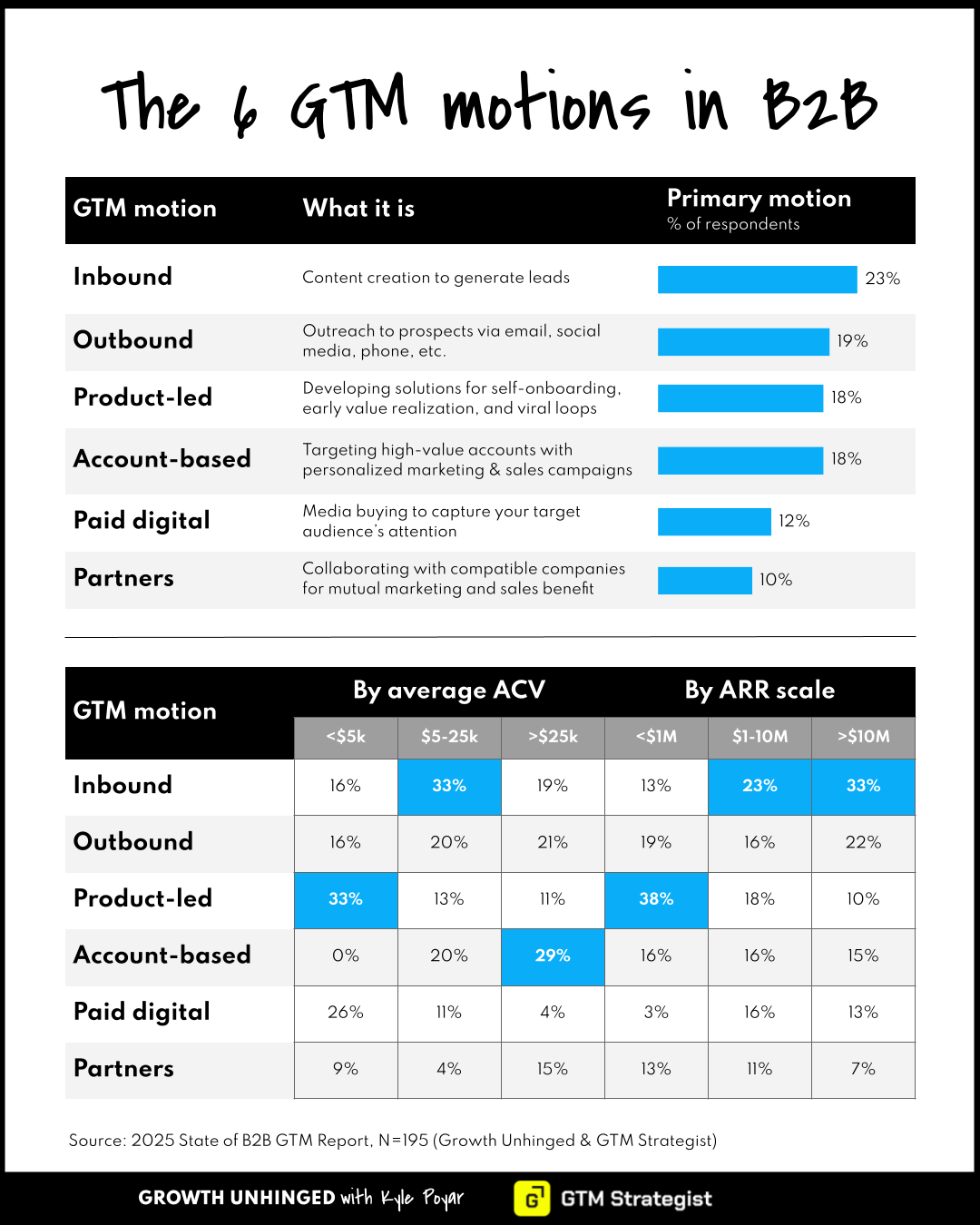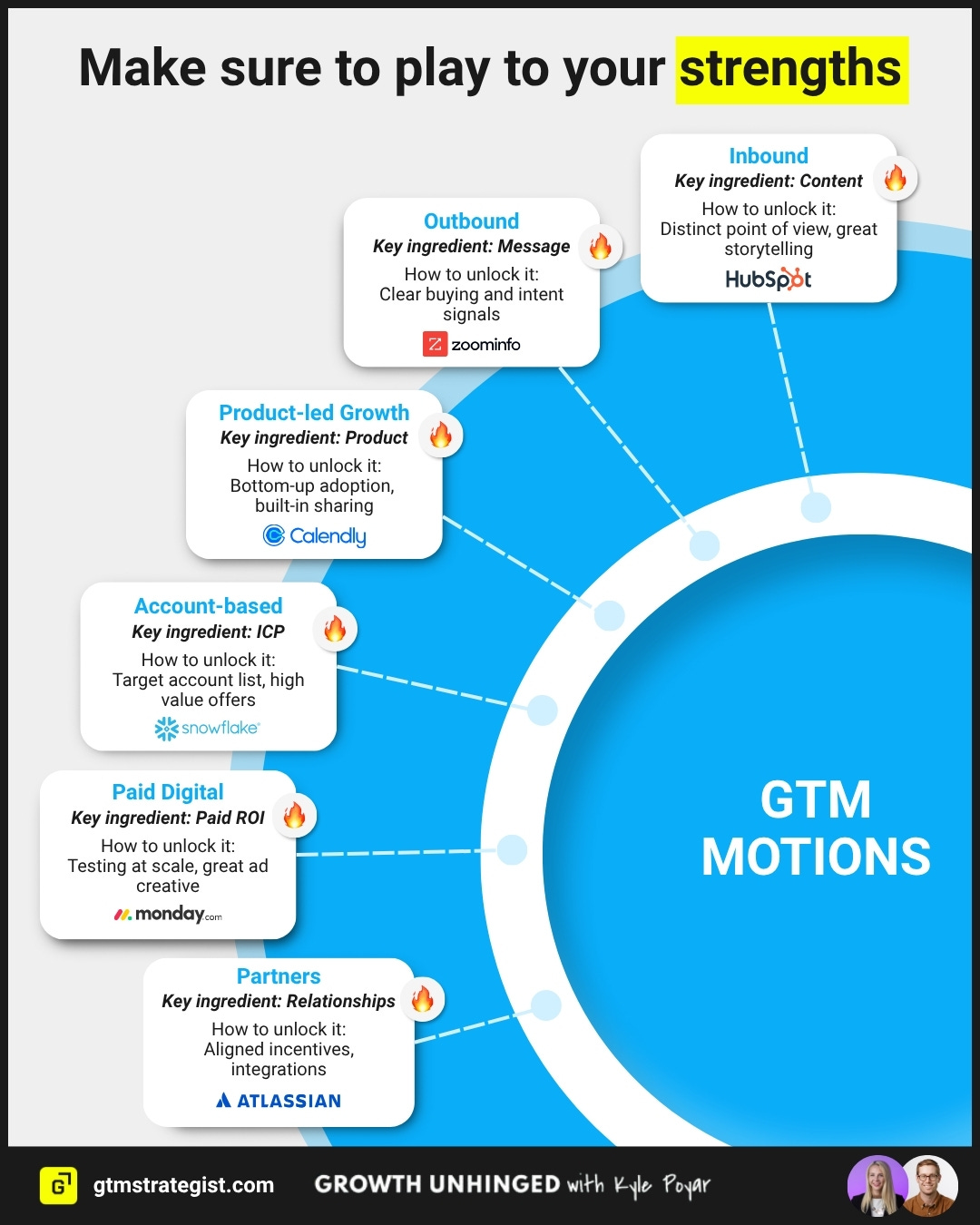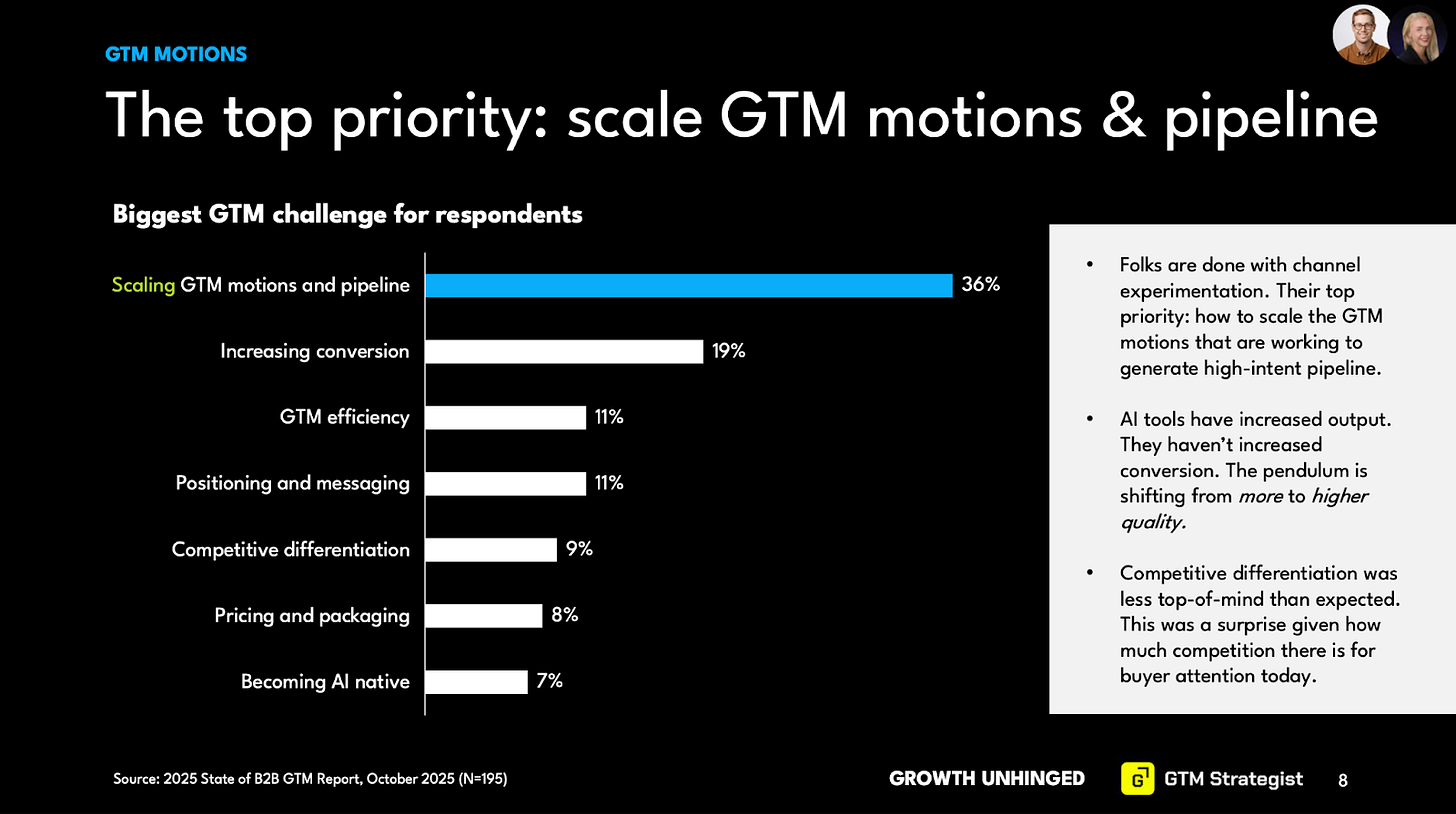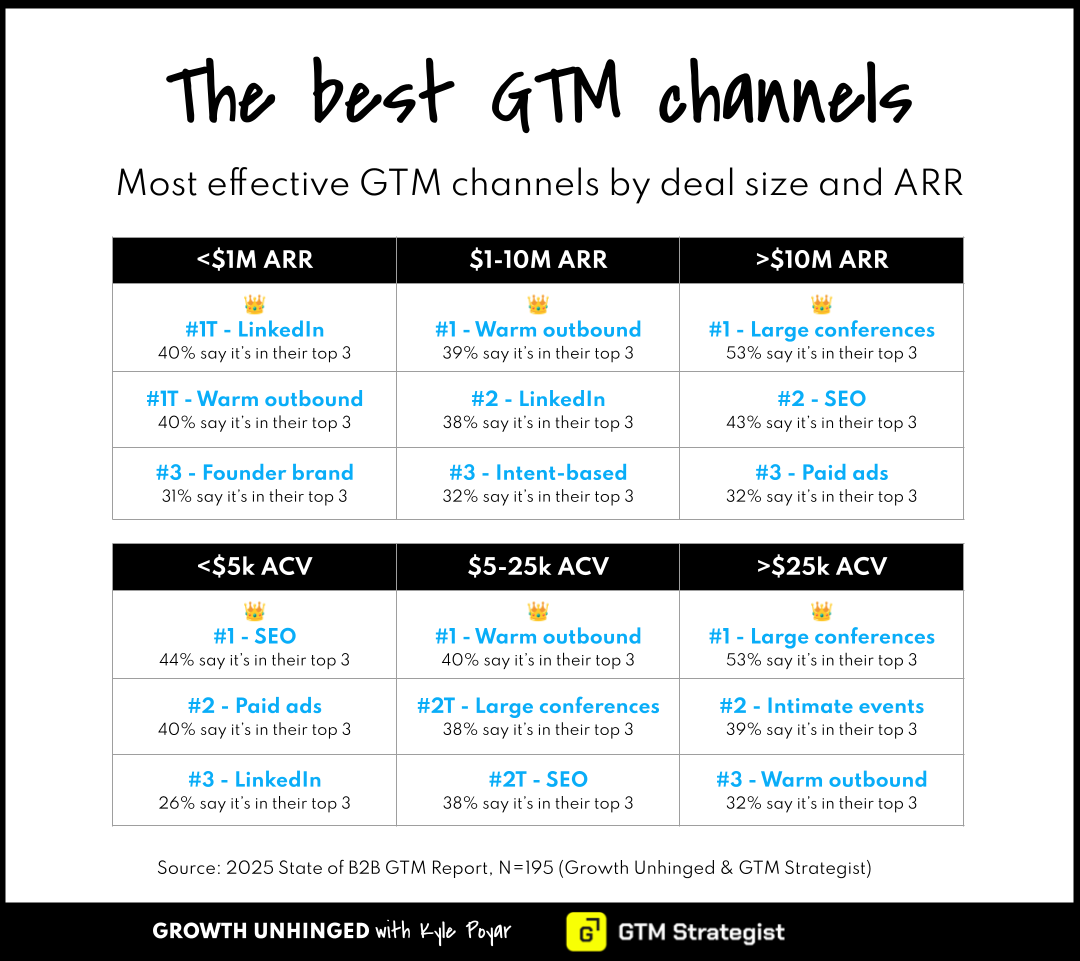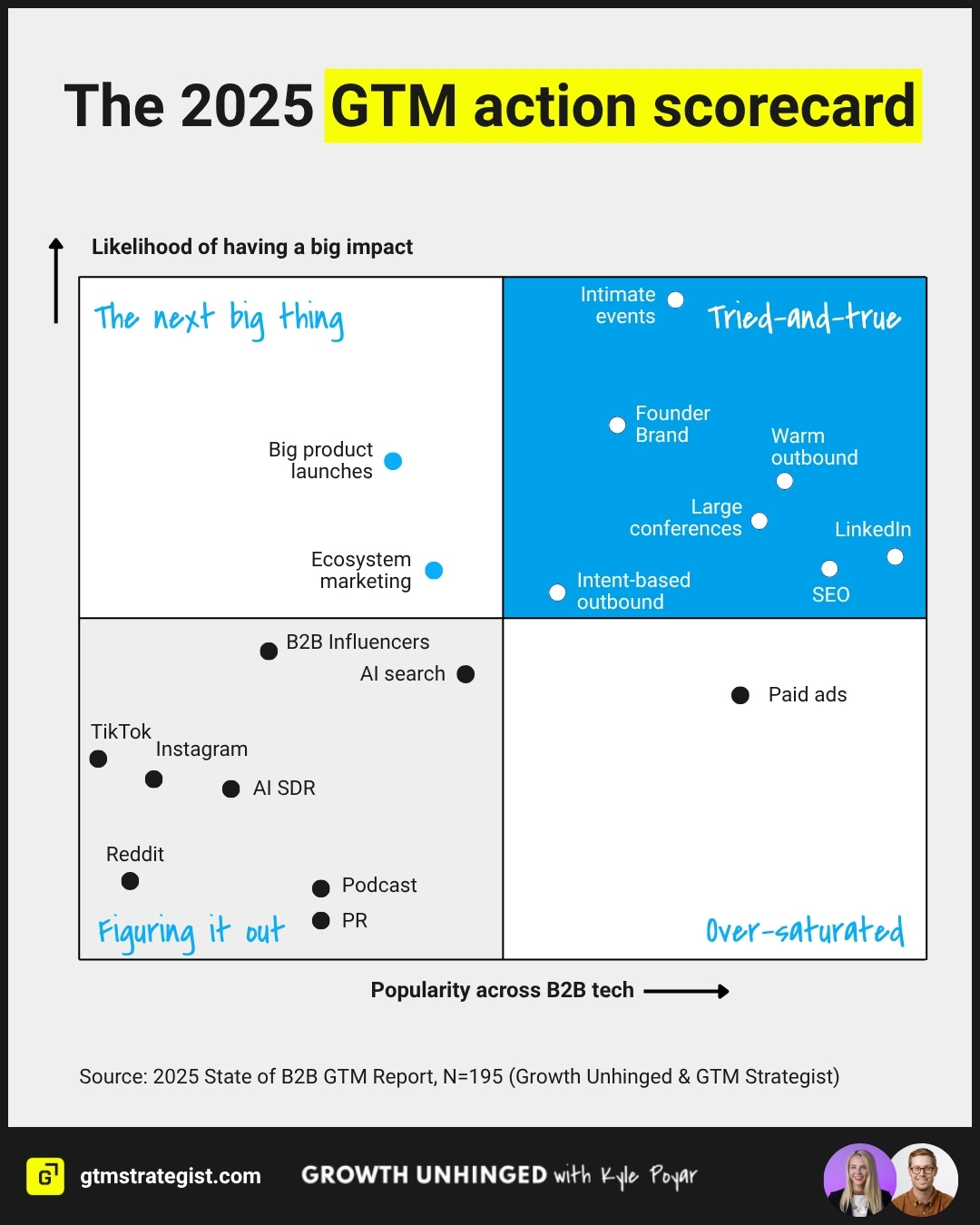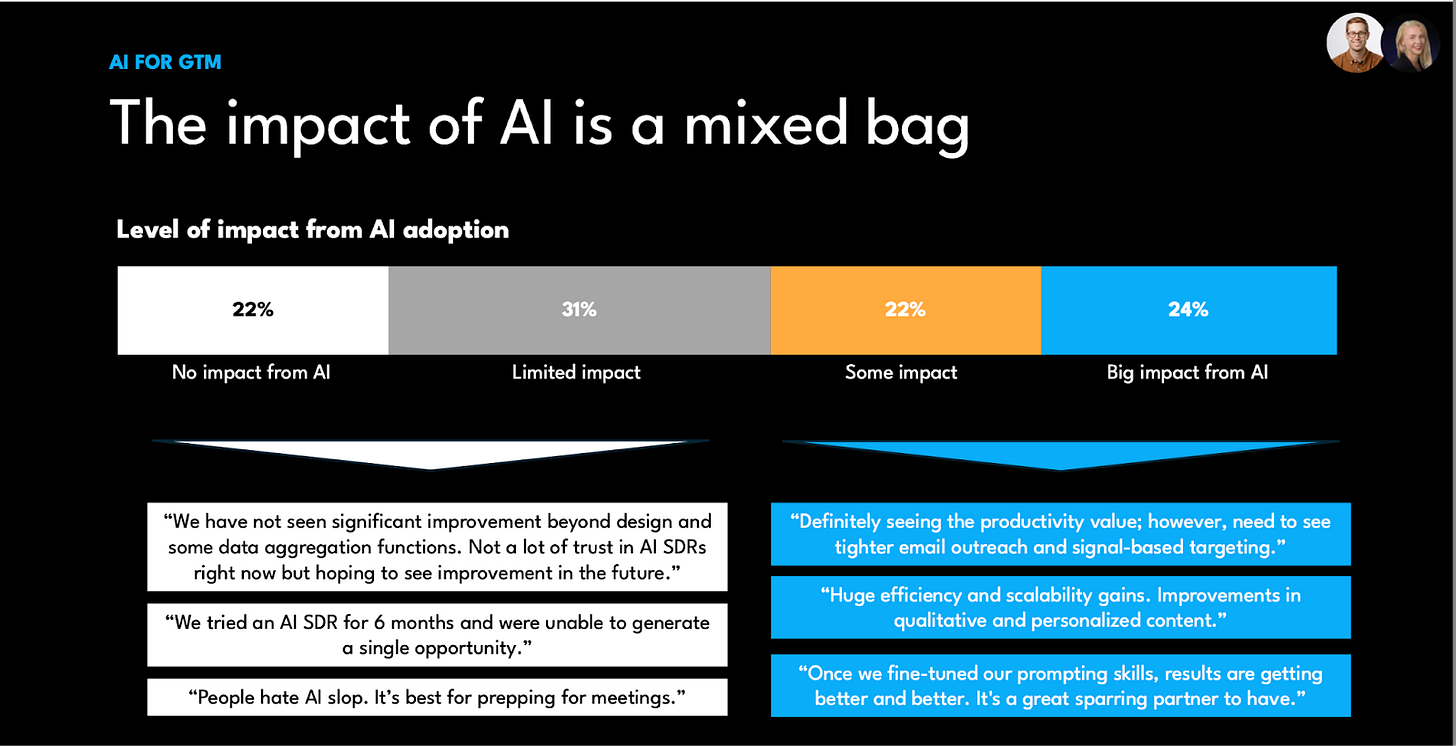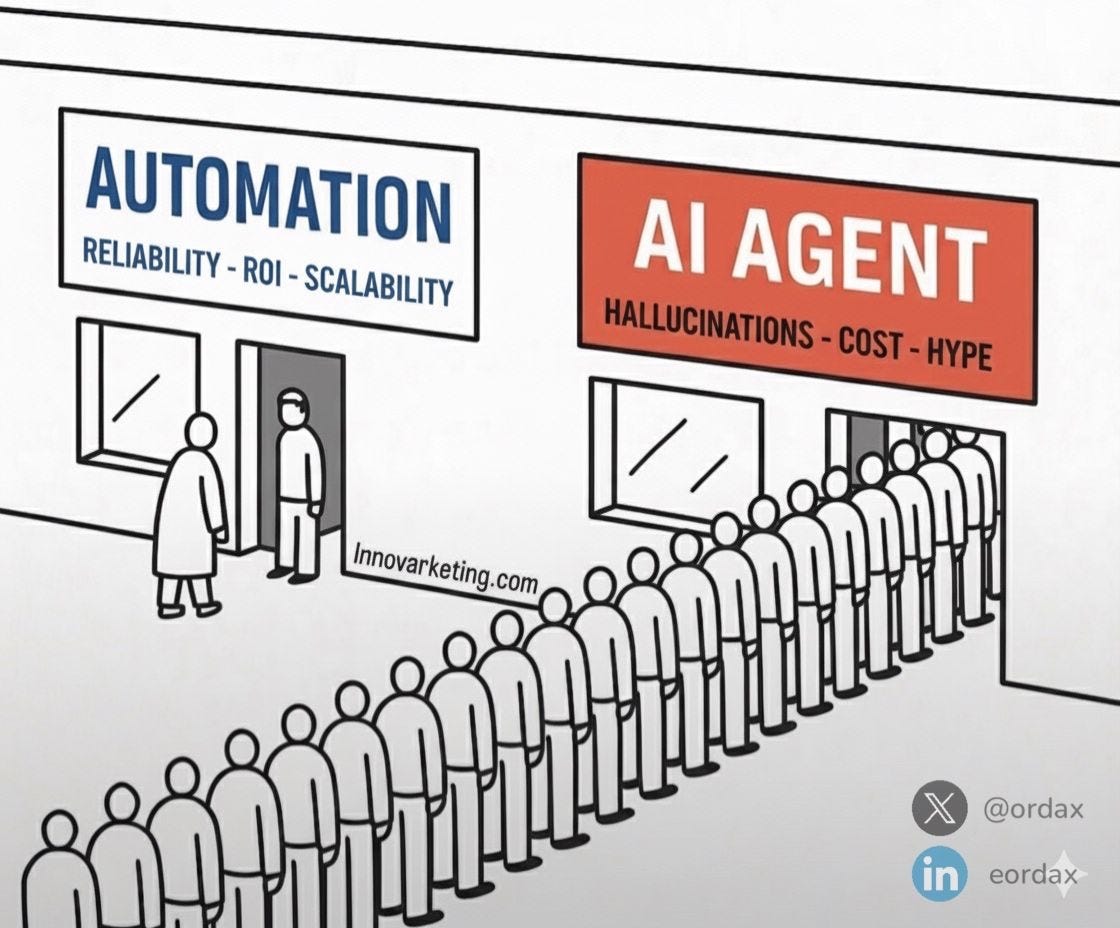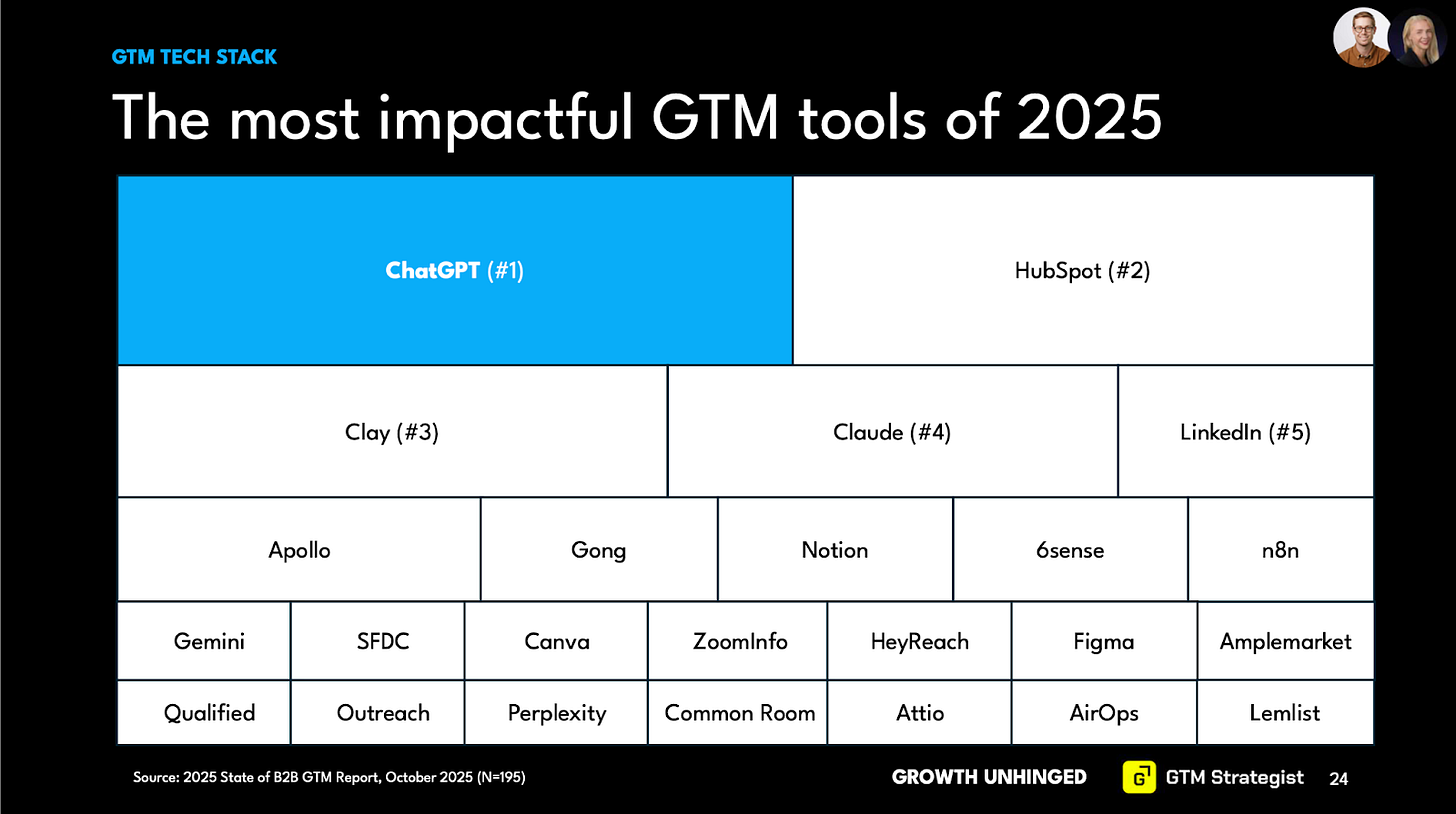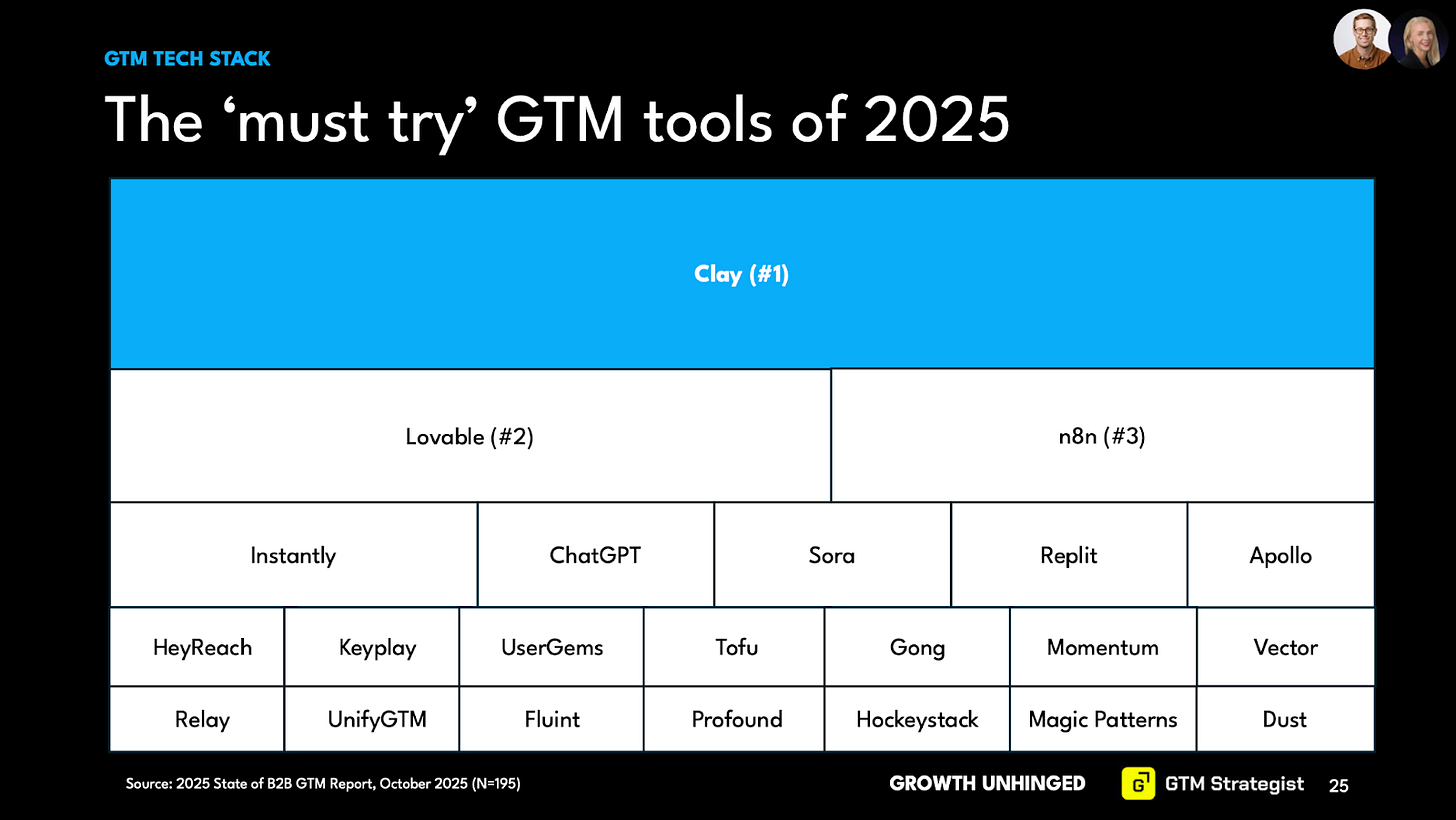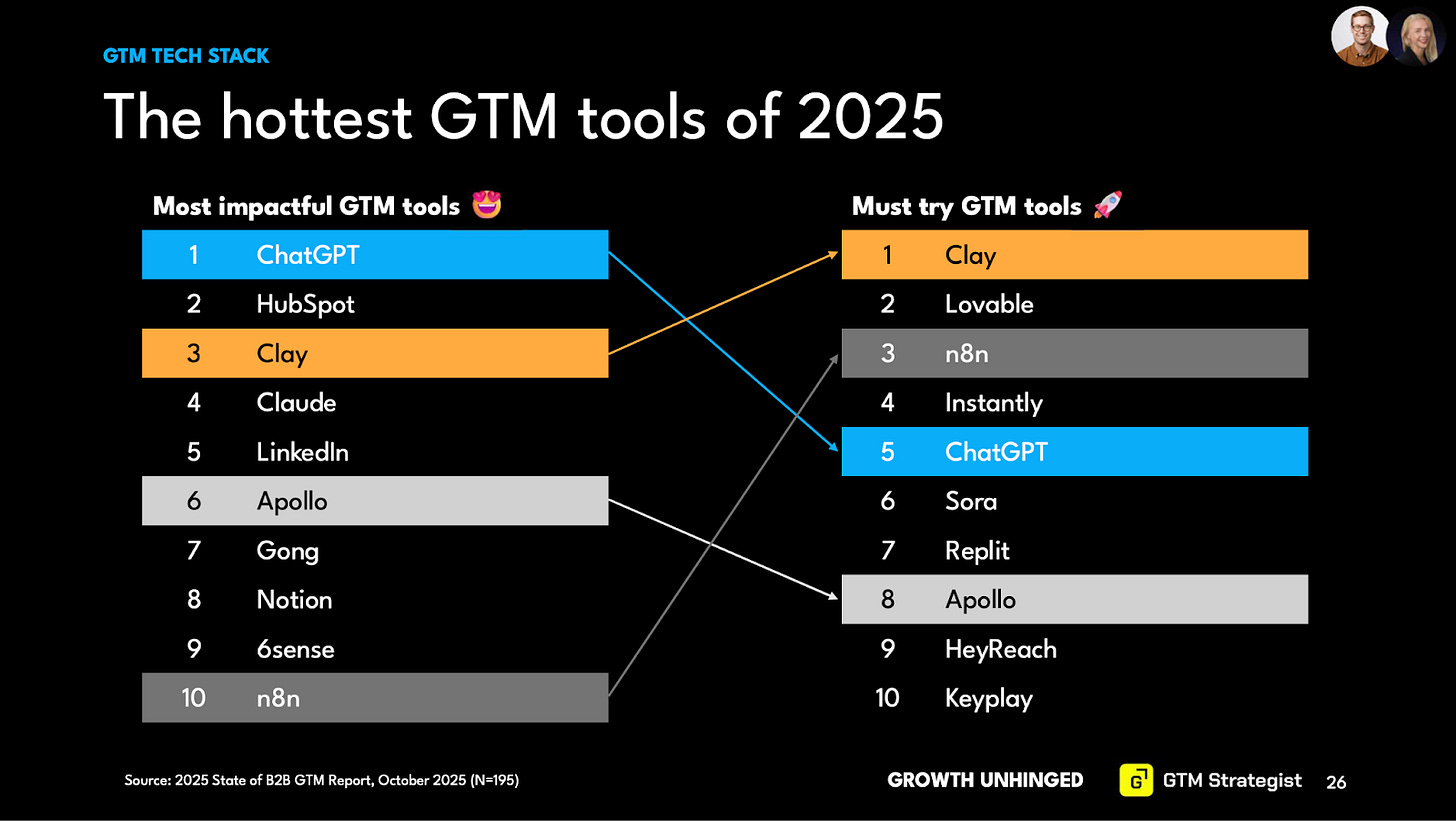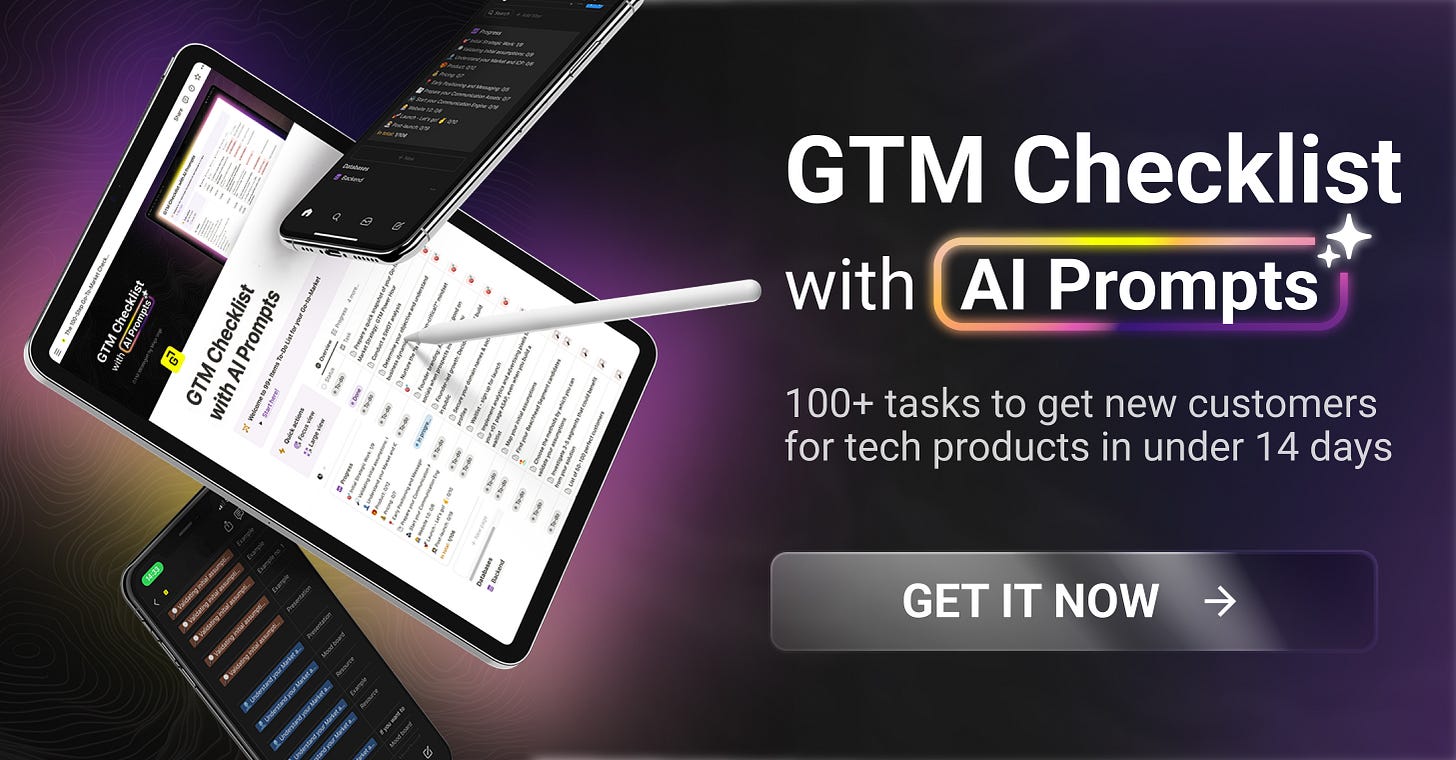The 2025 State of B2B GTM: What’s Actually Working
195 companies. 6 GTM motions. One unmistakable message: The exploration era is over.
Dear GTM Strategist,
This time, we have some hot proprietary insights to analyze. ♨️
In September, Kyle Poyar, the author of Growth Unhinged, and I joined forces to invite our communities to participate in the survey.
Thanks a million to all the community members who participated 🙏- you are the best! ✨
195 B2B software companies opened up about how they go to market.
If you are anything like me, you’ll want to learn more about the sample immediately so you can confidently decide how applicable and relevant these insights are for you.
Here it is:
By ARR: > $10M ARR — 43% , $1–10M ARR — 32%, <$1M ARR — 24%
Mix by average ACV (Annual Contract Value): <$5k ACV — 25, $5–25k ACV — 33%, $25k ACV — 42%
Mix by product type: Mostly SaaS — 40%, Hybrid — 28%, AI-native — 13%, Other — 19%
Geo: 63% of participants were from the US, 19% from Europe, and 8% from the UK.
Still here? Great.
Here are my top 5 takeaways from the analysis that will impact how I do my work in 2026. Some of them might be a bit spicy. 🌶️
There is no one-size-fits-all superior GTM motion. It all depends on your industry, deal size, company maturity, and #1 concern of companies ATM is how to scale and get more pipeline from GTM motions.
Everybody is looking for the “next big channel”. The average software company now runs 5 core GTM channels and another 5.5 experiments on top of them. That is a lot of work, especially for small teams.
The biggest bets at the moment on where to invest more are AEO (51%) and Intent-based outbound (45%), followed by LinkedIn and derivatives, aka founder brand and warm outbound (30%-ish).
In GTM AI adoption, we are moving from “what I could do with AI” to “show me ROI”. But the mainstream adoption is here: 91% of people said they use general tools such as ChatGPT as their AI GTM capacity.
ChatGPT also won the title of the most impactful tool of 2025 for GTM, followed by HubSpot and Clay. Must-try tools are Clay, Lovable, and n8n.
2025 was the year of “doing more.” Mass experimentation. Big AI promises.
2026 must become the year of focus, ROI, and scaling.
Kyle went deep into his analysis on his Substack, and here’s my take.
What is hot, what is not, and what are we doing wrong.
So we can sharpen our GTM muscles to make 2026 more impactful for our orgs. 🤘
Momentum kindly supports this Substack. Collecting, analyzing, and fetching data for such research takes a lot of time and resources. Imagine you could derive these insights from your sales and business development calls, without annoying your customers and leads with 10-minute surveys.
Now you can - Momentum just launched Deep Research, and the full power of it is demonstrated in their Voice of the Market & AI Maturity Report (analysis of 1,069 honest B2B sales conversations across 150 industries) - 56 slides and 42+ proprietary visuals based on insights from calls.
Download the report - and see the true state of AI in organizations and where we are heading in 2026.
PS: Momentum was also independently named one of the Top 15 “must try” GTM tools in our survey. Congrats, team, and thanks for being such a great partner! 💚
1. Six motions, one reality: We need better ROI and scaling
Our research identified six dominant GTM motions across B2B: inbound, outbound, product-led growth (PLG), account-based (ABX), paid digital, and partners.
Methodological difference is that we removed “community” from my initial model and packed account-based marketing (ABM) and account-based sales (ABS) together as ABX - anything :) - they should work hand in hand.
Now, what works and what does not? Depends on who you ask:
Inbound remains the most common motion overall, especially among companies with higher revenue.
PLG dominates for products with ACVs below $5K, where fast onboarding and built-in virality drive adoption.
Account-based (ABX) takes the lead above $25K ACV, where personalization and executive buy-in matter most.
Interestingly, the report found no correlation between GTM motion and growth rate.
Every motion can work if you do it right. 🤠
When asked for their top challenge, 36% of respondents said “scaling GTM motions and pipeline,” followed by “increasing conversions” (19%), and “GTM efficiency” (11%). Less directly ROI-related areas, such as positioning and messaging, differentiation, pricing and packaging, and becoming “AI native,” are in the second plan.
You can think about this from first principles:
WHAT do we want? Better results, ROI.
HOW will we get them? By nailing positioning, pricing, and becoming AI native. 🤷
That gap says a lot about where teams are spending time — and where they should be spending it.
That’s great. But what exactly should I do or plan for 2026?
For those two that might not understand the difference:
GTM Motion = a predictable and scalable way to get customers
GTM Motion > Channel :))
GTM Motion ⋍ proven combinations of channels, tactics.
Now, let’s dive into what channels and tactics have worked well for the companies and find some good candidates for your 2026 investments.
2. The Channel Scorecard: What works best & follow the money to figure out what is next
Similarly to GTM motions, there ain’t no “silver bullet” channel either.
The 2025 GTM Scorecard paints a crowded picture.
Reportedly, these are the channels that work best for certain groups of companies:
For companies over $10M ARR: large conferences, SEO, and paid ads
for $1–10M ARR: warm outbound, LinkedIn, and intent-based outbound
for under $1M ARR: LinkedIn, warm outbound, and founder brand.
And based on the ACV:
For deals over $25K: large conferences, intimate events, and warm outbound;
for $5–25K: warm outbound, large conferences, and SEO
or under $5K: SEO, paid ads, and LinkedIn.
Sounds rather old school - doesn’t it?
Well, there is nothing wrong with old-school if it is working well, but it is good to have at least 10-20% of GTM/marketing budget out there to “future proof” your company and take a screenshot now because this is the money shot 📸 - here are the “hot and new channels”:
As a trained marketer, I do have some commentary on this.
Over-saturated: Paid ads, I get it, it is tough, and it is not gonna get easier - constant ROI battle with ad creatives, platforms, and delivery mechanisms. It still works, though, but get ready for massive experimentation, and have a testing budget ready.
Figuring it out: AI search and its current correlation with Reddit make this opportunity interesting and trending. While I think there are some leftovers of Gary Vee and Chris Walker playbook or “content repurposing machines” - which was popular like 5 years ago in B2C but is now eaten by AI, so unless GenZ and decision makers will have massively different channel preferences than we do, that is not where my money is. Now interesting: AI SDRs - Kyle pulled this statement from one of the survey responses: “We tried an AI SDR for six months and were unable to generate a single opportunity.” There is a lot of talk - little action. Although I do know teams that do it very well.
The next big thing: While I was happy to see ecosystem marketing there, like Emily Kramer a year ago 🔮 - I do not understand precisely what big product launches mean - Apple events, GPT-5, Sora ??? 😄
Follow the money is the logic that takes me the furthest in life and business.
When it comes to GTM channels where respondents plan the most significant investment increases, two big winners are AI search (AEO) and intent-based outbound. Intent-based is the new paradigm in outbound because the only person who has not reported diminishing returns on pitch-slapping mass widely available contact bases is Sir Nigerian Prince 👑.
These are the two fronts where I’ll definately do purposeful experiments in 2026.
What else do you see here that you like or don’t like?
Let me know in the comments! Substack is much more fun when I hear back from you.
Back to Hype Machine: GTM AI - time to show some ROI, baby!
3. AI adoption in GTM is mainstream, but its impact is uneven
74% of companies say they have a top-down AI adoption mandate (28% hard, 46% soft). Yet only 24% report a “big impact from AI.” Kyle managed to pull some statements from the responses of those who are underwhelmed with the impact and of “the believers”.
Where AI is driving the most value was the next logical question to ask. From our survey findings, there are three groups where AI is already showing a satisfactory impact on GTM.
#1 - Outbound
Intent-driven outbound: deanonymizing website visitors, reaching out quickly with a tailored message
Automated SDR: messaging experiments, inbound qualification, and demo booking
Account targeting: identifying ‘look-a-like’ accounts, custom AI agents for lead scoring
AI agents on the website: chat agents to convert website leads and book meetings
#2 - Market intelligence
Competitor analysis: aggregating signals from competitors, AI agents to analyze win/loss data
Account insights: custom GPTs for meeting preparation, automated hand-offs from SDRs to AEs to CSMs
Data enrichment: AI-powered data enrichment and classification
#3 - Content marketing
Content generation: generating SEO-focused blog content, repurposing webinars into blog and social posts
GTM documentation: writing sales playbooks, call scripts, persona documentation, knowledgebase materials
Personalized messaging: AI-powered variables for email personalization
It was interesting to learn that almost every respondent (91%) uses mainstream AI tools such as ChatGPT, and 56% have deployed custom GPTs. I am still not sure if that number includes projects and shareable projects too - but that is another secret I’ll never know 🙂
Other BIG categories of tools are vibecoding/prototyping tools (41%), AI agents (41%), and multi-agent workflows (21%). The high use of AI agents came as a pleasant surprise to me, but, then again, I suspect this is connected to the loose use of the term.
To me, an agent self-learns and performs actions autonomously, but lately I’ve seen a lot of n8n workflows being baptized as agents, even though they don’t go beyond LMS automations.
Rant over - I like agents, I just don’t like to overhype their usage to something that would be quicker and cheaper to do with Zapier. Because if that becomes “the taste of agents”, they will surely not live up to the hype.
And this is a brilliant hook for the next section of the report. I’d like to present you: the tools. 🛠️
4. The 2025 GTM Tech Stack
Kyle was really clever to ask these questions in two ways:
What are the most impactful GTM tools for you NOW?
What are the “MUST TRY” GTM tools for the future?
Observe these two slides for a sec:
In the “most impactful” category, you’ll see a rather typical B2B toolset - how we run our processes, mainly mature tools and AI models + mainstream solutions. Some purposefully built GTM tools did pop up, but mostly, the fundamental layer of how we run our GTM operations.
Seeing this made me think of a super-interesting interview Lenny did with Brian Balfour, where he predicted it will that ChatGPT will be the next mega growth channel.
The must-try gets really interesting.
Clay jumps to #1, signaling that enrichment and automation are becoming the new GTM superpower. Lovable (#2) and n8n (#3) rise as symbols of the AI-native wave, and we see more AI native GTM tools popping up.
To me, the message is clear: the GTM tech that got us here won’t get us there. We should experiment with the new tools purposefully because we will be held accountable for the ROI of these implementations.
While LinkedIn is debating whether GTM engineering is a bug, not a feature, a symptom of tool complexity and unpredictability, I don’t care much how it is called. I am happily building my agentic and non-agentic n8n workflows. I remember vividly when GTM practitioners were skeptical if we could use ChatGPT reliably in 2023. Now more than 91% of folks who answered the survey rely on it.
5. What to double down on in 2026
The closing message of the report is unambiguous:
2025 was a year of endless exploration.
2026 must be the year of ruthless scaling.
We no longer have GTM motions in single-player mode; it’s now multiplayer.
Allbound, ABX, mixbound, however you want to name it - modern GTM systems respond to real-time buyer intent. GTM motions need to be orchestrated around the buyer’s journey.
AI brought predictive intelligence to the mix, enabling us to detect and reach prospects much sooner with more tailored messages. So can our competitors. Detecting high-quality signals has become the new oil, and we need a technical stack and the capacity to capture them first.
In the age where buyers are discovering our brands in answer engines' zero-click environment, and entry barriers to producing decent content with AI are close to nada, we have to recall that every trend has an anti-trend.
In the age of AI content commodities, AI clones, mass production and cluttered inboxes of overwhelmed decision makers, trust, brand, intimacy, a really unique point of view, and indisputable credibility of talking human truth inherently become more valuable. Not a luxury per se, but that can become an intangible asset. Yes, invest in your AI tech skills, but also invest in your brand, your relationships with trust centers (partners, opinion leaders, relevant communities, tastemakers), and your customers. Think beyond touchpoints in their customer journey; create trustpoints - those experiences that buyers remember for months, years, and lifetimes.
Thanks again to Kyle Poyar for initiating this research, and all of you who kindly participated in this research. 🙏 This writeup would not have been possible without your help.
I’d love to learn what your key takeaways were from this report.
What do you see in your business?
What do you disagree with?
What surprised you?
I hope to exchange some good thoughts in comments, and if you’d like to support Kyle’s work, you can do so by subscribing to his paid Substack.
If you like what I share here and want to support the mission, sponsorship support, and your purchases of our digital products support design, content creation, and distribution efforts to keep the GTM Strategist Substack (hopefully) interesting and valuable. ✌️
📘 New to GTM? Learn fundamentals. Get my best-selling GTM Strategist book that helped 9,500+ companies to go to market with confidence - frameworks and online course included.
✅ Need ready-to-use GTM assets and AI prompts? Get the 100-Step GTM Checklist with proven website templates, sales decks, landing pages, outbound sequences, LinkedIn post frameworks, email sequences, and 20+ workshops you can immediately run with your team.
🏅 Are you in charge of GTM and responsible for leading others? Grab the GTM Masterclass (6 hours of training, end-to-end GTM explained on examples, guided workshops) to get your team up and running in no time.
🤝 Want to work together? ⏩ Check out the options and let me know how we can join forces.




